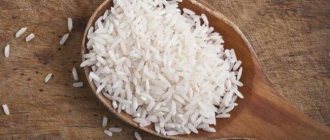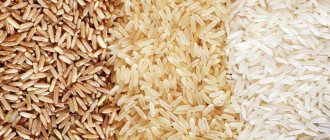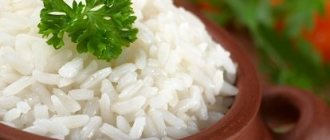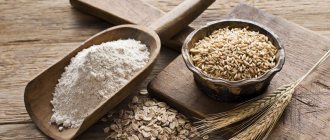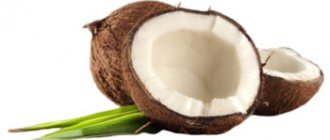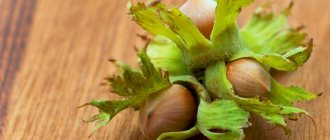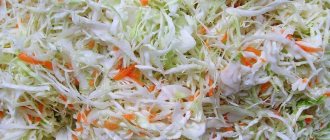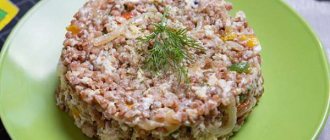Brown rice is a minimally processed product, which allows it to retain more of its nutritional properties, fiber and nutrients. The plant's homeland is Asia (Northern Thailand and Vietnam). The culture was grown in ancient times, as evidenced by archaeological finds - pottery with the remains of cooked rice. But over time, new varieties appeared in South Asia, which adapted to the environmental conditions and climate. Thus, in Japan and Korea, round rice is grown, which is resistant to cold night temperatures and is not afraid to remain without moisture for a long time. South Asian varieties are moisture-loving and can withstand extreme heat and scorching sun.
To grow the crop in Northern and Central Europe, it was necessary to work hard: the climatic conditions were not at all suitable for rice. The fashion for this product came here only after the plague epidemic in the European south, when there was no one to grow the demanding wheat, process it and prepare it for consumption. Unpretentious round rice - a high-calorie, tasty and satisfying product - helped the population who went through a difficult period not to die of hunger. So the culture began to spread throughout the continent, but still remained a secret for the population in the territory of modern Russia. The culture came here only a hundred years ago, when it was successfully planted on the Rostov, Astrakhan, Stavropol and Krasnodar lands.
a brief description of
Brown rice is a cereal crop that contains many beneficial nutrients. Therefore, this product is popular among people who adhere to proper nutrition and diet.
The Japanese mostly eat white rice (the grains are round and short) rather than brown. This is due to the fact that after cooking, polished cereal sticks well, which makes it possible to make various flatbreads, sweets and other dishes from it.
Some argue that wild rice is brown rice. But this is not true. The first is not rice grain, but rather a perennial grass that is grown in North American lakes. The grains of this product are very hard, so they should be soaked in water for several hours.
What does it look like?
Brown rice is a long, thin brown grain from which only the yellow outer husk is removed, leaving the bran coat intact. This is why rice has a brown tint.
Taste
Brown unpolished rice has a nutty flavor due to the fact that the grains have a bran coating, which gives the product a special taste.
Smell
Brown rice has a specific aroma, but not too rich. However, if there is a smell of rancid oil, it means that errors were made in the storage conditions of the product.
Step-by-step preparation
The dish is prepared for 1 hour:
- First, prepare the broth (vegetable): wash and peel the vegetables (stem celery, carrots and onions). Add bay leaf, black peppercorns and cilantro. Boil the broth until done.
- Measure out the rice. It is better to use the long-grain Indica Brown variety, which is carefully ground, preserving the grain germ and shell.
- Chicken breast fillet is cut crosswise into strips. Mix with 1 tbsp. l. vegetable oil, half the available garlic (chopped) and curry and marinate.
- Peel and chop the onion. Heat the oil (vegetable) in a deep frying pan, add the onion and garlic (remaining) there, then cook for about three more minutes.
- Add rice, sprinkle the remaining curry over the dish and mix well.
- Pour broth (hot) into the cereal. The proportion should be: 1:2.5. Add salt (1 tsp) and raisins. Cover with a lid and cook for about 25 minutes.
- Roast nuts (pine nuts). Chop the tomatoes and cilantro and add them to the finished cereal. Stir and heat for five minutes.
- Fry chicken breasts (pre-cut into strips).
- Fluff the rice with a fork, sprinkle with nuts and place fried chicken strips on top. Serve with a slice of lemon.
How is brown rice different from brown and white?
Brown rice is also called brown rice, so they are the same thing and there is no difference between them.
White and brown rice grains are the same type of grain. However, the products differ from each other in the degree of processing.
Before white rice is packaged and sent for sale, the grains are carefully cleaned and polished. During the processing, the germs and husks are removed. This increases the shelf life of the product and also prevents the risk of harmful microorganisms appearing in it. © https://ydoo.info/product/korichnevyy-ris.html However, due to processing, white rice loses a large amount of nutrients.
Brown rice, unlike white rice, undergoes only a minimal degree of processing. Therefore, fiber and nutritional components are fully preserved in such a product. But the shelf life of brown rice is not as long as that of white rice. Quite often, mold and harmful microorganisms develop in the product. In addition, during cooking, brown grains can become very soft if left on the stove.
It is worth noting that white and brown rice grains differ in nutritional value. Brown rice contains a large amount of fiber, and white rice contains carbohydrates. In this regard, the first one refers to dietary products.
Recipe for pilaf with fried chicken breast
Fluffy brown rice with spices, garlic, tomatoes and fried chicken has a great flavor profile. A green salad with lemon is an ideal addition to it. Product composition:
- two chicken breasts;
- 200 grams of brown rice (“Indica Brown”);
- 600 ml broth (vegetable, chicken) or water;
- 100 grams of cherry tomatoes (regular can be used);
- 50 grams of raisins;
- 25 grams of pine nuts;
- two cloves of garlic;
- one head of onion;
- 3 tbsp. l. vegetable oil;
- 1 tbsp. l. curry (mild powder);
- half a bunch of cilantro;
- 1 tsp. salt;
- for serving - lemon.
From the presented quantity of products you can prepare 6 servings of the dish.
Brown rice varieties
Brown rice generally comes in long and medium grain varieties. The first one is quite long and thin. The crop is cultivated in America, Australia and Asia. Long grain rice will not overcook, stick together or expand in width. This type of brown rice absorbs only a small amount of liquid and ends up fluffy. It will take approximately 20 minutes to cook this product.
It's also worth noting that long grain brown rice is a versatile food. It can be added to salads, vegetable dishes, and used as a side dish for fish, meat or poultry.
Absolutely all varieties of long grain rice have the same name - “indica”. The varieties “jasmine” and “basmati” are close to them. The latter is more suitable for a side dish, since it turns out crumbly, and the former is advisable to use when preparing porridge, because after cooking it becomes sticky.
Medium grain rice is distinguished by wide and short oval-shaped grains. Cultivated in America, Australia, Italy, and Spain. This type of rice is not very transparent and contains a large amount of starch. During cooking, it absorbs a lot of water, so the grains become sticky, viscous and soft.
Since medium-grain brown rice strongly absorbs the odors of other ingredients that are part of the dish, the product is best used for making soups, risotto and paella. In addition, medium-sized grains are suitable for creating pilaf, porridges and side dishes.
The most popular variety of medium grain brown rice is the Italian Arborio variety, which is wide translucent grains with an opaque core. When cooked, rice takes on a creamy hue.
How to choose?
To choose the right brown rice, you need to buy the product in transparent packaging. This way you can consider the quality and appearance of the product.
All grains should be whole, the same size and have a light brown tint. If there are green grains in the package, it means that the rice is not yet ripe, and it is not recommended to eat it.
In addition, you need to pay attention to the packaging date of the product. Fresh grains will always be of high quality. However, as for the basmati variety, its aroma and taste are fully revealed after a year of storage.
You can also tell that a package contains low-quality rice by the different shapes of the grains and the presence of husks. Chipped grains will cook faster than whole grains. As a result, the finished dish will have a non-uniform consistency.
How to store?
If stored in a sealed package, brown rice can be stored for up to 12 months. After opening the package, the product must be poured either into a sealed plastic container or into a glass container with a tight lid. During storage, moisture should not penetrate into the container with rice grains. Otherwise, the shelf life of the product will decrease, and bugs, mold and harmful microorganisms will appear in the grains.
The optimal temperature for storing brown rice is no higher than +15 degrees. The humidity level should not exceed 70 percent. In addition, the container with grain should be located in a dark place where the rays of the sun will not penetrate (a kitchen cabinet or pantry will do).
Rice should be on the same shelf with other types of cereals, away from aromatic spices.
Dry rice can also be stored in the refrigerator compartment. Due to this, insects will not appear in the product. Additionally, brown rice grains can be frozen. The shelf life of the frozen product is no more than 8 months. The cereal must be distributed into bags, sealed plastic containers, or left in the packaging and sent to the freezer.
Boiled rice must be stored in the refrigerator. The shelf life of the dish is no more than 3 days. In this case, the product must be placed in an airtight container so that the rice does not absorb foreign odors. But if the product was cooked with milk, then it must be consumed within 24 hours.
Cooked rice can be kept in the freezer for up to 3 months.
At a temperature of +10...+30 degrees, boiled rice grains can be stored for 3 hours. Afterwards, the product is not allowed to be eaten.
How to cook crumbly?
Unpolished brown rice has a specific taste that you get used to over time. It is also worth considering that this type of cereal takes much longer to cook than polished white grains.
Rice can be boiled not only in a saucepan on the stove, but also in a double boiler, as well as a slow cooker. However, before cooking, the product must be rinsed several times under running water in a sieve until the flowing liquid becomes completely transparent. Due to this, you can wash away all the dust and dirt that has settled on the cereals. After washing the grain, it is advisable to soak the grain in cold water for 30 minutes (some cooks soak the grain for 3 hours or overnight) to soften the hard shell.
How long does it take to cook brown rice? On average it takes 40 minutes to cook. If the grains are not pre-soaked, the cooking time increases by another 15 minutes.
To make the rice crumbly, you will need 2.5-3 cups of liquid (either water or broth) per glass of cereal.
In a saucepan on the stove
After washing and soaking, the rice grains are placed in boiling water or broth.
Rice and water should take up no more than ¾ of the pan's volume. This is required so that the resulting steam remains in the container. Thanks to this, the cooking process will go much faster.
The liquid is usually salted before the rice is added to the pan. But there is an opinion that it is better to add salt later, 15 minutes before the end of cooking, when the rice has already boiled and absorbed the required amount of liquid. It is advisable to try both options to choose the one you prefer.
The beans are cooked without a lid for the first 20 minutes. There is no need to stir the cereal with a spoon. It is enough to simply remove the foam that forms from the surface of the liquid. Then the fire must be reduced to minimum, cover the pan with a lid and cook the rice for another 20 minutes. After this, the product should be placed in a colander to drain excess liquid. Then the finished rice porridge is again placed in the pan, where the butter has been added. The dish can be served in five minutes.
There is a way to quickly cook brown rice in a saucepan on the stove:
- Rinse the rice and soak for 20 minutes.
- Place the grains in boiling liquid and cook over high heat for 5 minutes with the lid closed.
- Turn the heat to medium and simmer for another 5 minutes with the lid on.
- Then, over low heat, the cereal should simmer for 3 minutes.
After this, the pan with the contents should be wrapped in something and placed in a warm place for 10 minutes. There is no need to drain the liquid from the rice. After the specified time has passed, you can add butter to the porridge.
In a slow cooker
To prepare brown rice in a slow cooker, the grains must be thoroughly washed and soaked in cold water (the technology was described above).
After this, the product is poured into the bowl of the device, the required amount of liquid is poured in and salt is added. On the multicooker, you should set the “Grains” or “Rice” program. Cooking time – 30 minutes. At the end of the program, stir the rice and add butter.
In a steamer
To cook brown rice in a steamer, you must first thoroughly rinse the grains. Then place the product in the bowl of the device intended specifically for rice. If you don't have such a bowl, you will need to line the bottom of the container with foil. Using a toothpick, make small holes in the foil. Only after this can you lay out the cereal. It is advisable to immediately add spices to the grains and mix. Pour water into the device, cover with a lid, and set the timer for 60 minutes.
If the steamer model is not very powerful, the cooking time can be increased.
Boil the product in oil
Rice (one glass) is thoroughly washed with cold water. The flowing water should be absolutely transparent. Heat a deep frying pan, pour oil into it and add rice. With constant stirring, the cereal is slightly dried. The oil should kind of envelop the rice grains, which should prevent them from sticking together. Then pour water (three glasses), stir (only once!) and leave until boiling over high heat. After the water boils, reduce the heat to low, close the lid and leave until the water is completely absorbed. Then turn off the fire, cover the pan with a lid and leave the rice to simmer for about half an hour.
Health benefits and harms
Since the product undergoes only a small degree of processing, brown rice grains retain a large amount of oils, fiber, proteins, minerals and trace elements.
Brown rice is recommended for adults and elderly people, children, pregnant women and diabetics. Since the product does not contain gluten, the product can be eaten by people who are allergic to this component.
The product can also be used for gastrointestinal disorders. Without irritating the mucous membrane, the grains gently envelop the walls of the intestines and stomach, thereby exerting an astringent and disinfecting effect. In addition, consuming the product helps replenish the supply of mineral elements that are washed out of the body during diarrhea.
On average, the calorie content of the product per 100 grams is 330 kcal. However, despite its high energy value, brown rice contains many useful substances. Regular, but not excessive consumption of grains will only benefit the body.
What other beneficial properties does brown rice have?
- if you regularly include brown rice grains in your menu, you can relieve inflammatory processes in body tissues, remove skin rashes, strengthen the nail plate, and also improve the condition of your hair;
- can be eaten for gout, dermatitis, eczema, arthrosis and arthritis to get rid of diseases of the skin and joints;
- recommended for use during PMS and menopause, as well as for athletes and people on a diet, to restore strength and eliminate the feeling of hunger for a long time;
- brown rice relieves irritability, headaches, fights depression and insomnia;
- the product reduces the level of acidity in the stomach, eliminates heartburn, and also normalizes metabolism;
- Brown rice grains reduce blood sugar levels and remove cholesterol plaques from the walls of blood vessels.
You should eat unpolished brown rice three times a week. Only in this case can you benefit from the product.
Brown rice has no special contraindications. If you use the product too often or in large quantities, you can harm the body, causing bloating, flatulence, constipation and the development of atherosclerosis, urolithiasis and hypertension. It is also not allowed to eat if there is an individual intolerance to the product and for people who are obese.
Contraindications
Natural brown rice has virtually no contraindications. The only group that is not recommended to eat cereal is those suffering from gastrointestinal diseases, in particular constipation and acute inflammation.
READ ALSO: Simple and delicious recipes for cheesecakes according to Dukan
For everyone else, brown rice is healthy and necessary. Choose the grains to use carefully. The packaging must be sealed, with markings and information about the manufacturer. Rice grown near your country is the best option. During transportation, such a product will not have time to deteriorate and lose its properties.
Can it be used if you have diabetes?
If you have diabetes, you can eat brown rice, but only for those people who are not overweight. The glycemic index of brown rice is 50 units.
Experts allow people with type 2 diabetes to eat the product, since brown rice grains contain dietary fiber that reduces blood sugar levels. In addition, the product contains folic acid, which keeps sugar levels normal.
For diabetes, brown rice can be cooked with water, milk or broth, made sweet or salty, and added with fruits, vegetables or nuts. However, diabetics should remember that large amounts of the product can cause constipation.
